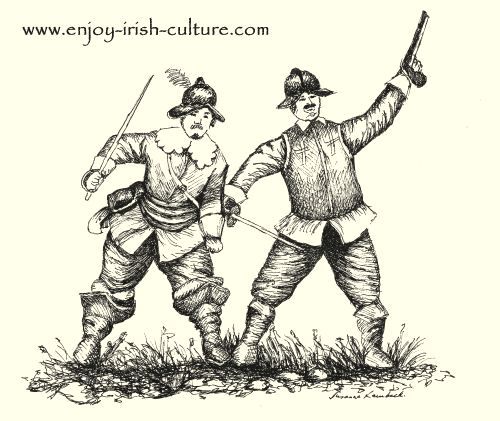The Cromwellian Conquest of Ireland and Irish Slavery
This page will tell the story how the Cromwellian conquest of Ireland resulted in slavery for many Irish in Barbados and the Americas.
Slavery as an Irish history topic? Yes.
 The Cromwellian conquest of Ireland- Cromwellian soldiers
The Cromwellian conquest of Ireland- Cromwellian soldiersThe Cromwellian New Model Army was the best organized army in the world at the time. Their heavy assault guns and other weaponry were far superior to what the Irish were fighting with a lot of who were fighting with pikes and pitchforks when they did not have rifles.
The First Victims of the Cromwellian Conquest of Ireland Were Irish Soldiers
After victory of the Parlamentarian Army, professional
Irish soldiers
were put into internment camps. About 38,000 of them were sold into
the armies of nations not at war with England- such as Spain, Portugal, and
Poland.
From a strategic viewpoint it was understandable that Cromwell wanted rid of the soldiers. Irish soldiers had a reputation internationally for being fierce fighters.
The soldiers were shipped off as soon as possible, and they were not allowed to bring their dependents. This meant there was now a huge population women and children that were financially unsupported, destined to go hungry.
The Hunt For More Slaves
Then, Cromwell systematically made sure the next harvest
was destroyed. He had organized that the army bring scythes. Houses,
which in those days were mostly wooden and wattle and daub cabins, were burned.
Many people were driven off the land and sought refuge in
the towns. This strategy increased the numbers of destitute. Destitution was then used to justify the rounding up of people to sell them into
slavery.
It was easy to target the homeless in towns. So called ‘man
hunters’ went around settlements on horseback with long whips forcing
people, men, women and children, into holding pens outside the towns from which
they were marched to the major ports, Kinsale, Bantry, or Galway.
English slave ships picked them up at the ports.
To sell the Irish as slaves was seen as natural by the English of the time.
The prevailing attitude was that an Irish Catholic was less than human. To kill them was a heroic act, profiting from Irish White slavery was seen almost as a humanitarian act.
Irish Slaves on Barbados
Most slaves were sent to Barbados which
today is a holiday resort. Back then, it was an English sugar plantation
that needed slave labor. Irish slaves were the answer.
Anyone who was considered to be a ‘vagrand’ or vagabond
(in other words homeless) or an enemy of the new regime such as the entire
Catholic clergy and anyone who was young enough to be useful for slave labor, was transported.
It is estimated that transportation to Barbados was the fate
of 50,000 Irish people between the years of 1652 and 1656. The practice
had become so popular, one resident wrote, that people had started to
"make a verb of it, to Barbados you“.
The Irish slaves were next in line to black slaves when it came to being exposed to cruel treatment. The Irish were considered rebellious. Plantation owners used extreme violence to ensure obedience.
In Barbados today there are still some descendants of
those Irish that were captured and sold as slaves. They are called the Red
Legs, a poverty stricken group of the population. Apparently they owe their
strange name name to sun burnt legs emerging from their kilts when
stepping off the slave boats first.
Read More About the Cromwellian Conquest of Ireland
Our article "Cromwell in Ireland" details the invasion and the atrocities that followed.
Read about the lifestyle of
the new ascendancy after Cromwell, and the architectural
legacy left by this elite.
Some Irish people were sold as slaves into tobacco
plantations in Virginia. In both places, the treatment of white
slaves was even worse than that of African slaves because Irish slaves were
much less docile than Africans.
Irish slaves led many rebellions in
Barbados. Beatings and torture of various kinds were common place as well
as unsafe and hazardous working and living conditions. None of the Irish
sold into slavery by Cromwell ever returned to Ireland.
At home, the slaves were forgotten, until the publishing of
an excellent book on the subject of Irish White Slavery which we have used a
resource for all the facts and figures quoted here: To Hell or Barbados by
Sean O Callaghan.
Return to the top of this page.
Return to Irish History
We invest a lot of our own funds and free time into this website so that you can find out about Irish culture, heritage and history.
Please return the favour and help us cover our cost by clicking on Google ads and/ or buying us a cup of coffee! Thank you so much in advance.
Warmest regards, Colm & Susanna
|
|
|
|
Enjoy this page? Please pay it forward. Here's how...
Would you prefer to share this page with others by linking to it?
- Click on the HTML link code below.
- Copy and paste it, adding a note of your own, into your blog, a Web page, forums, a blog comment,
your Facebook account, or anywhere that someone would find this page valuable.
|
|
|
|
- Home
Customs and Traditions
Travel
Music
Heritage
About This Website